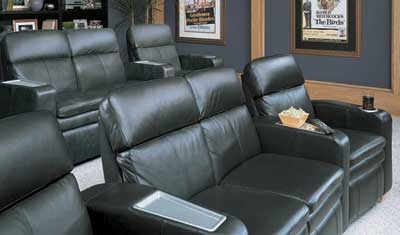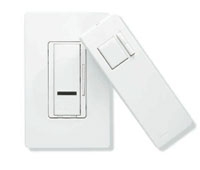Working the Room Page 2
Don't Get Too ComfortableWhile any comfy sofa or chair will do, "home theater seating" sets the experience - and the room - apart. Row-style seats that are permanently attached to the floor, like the ones in traditional movie theaters, as well as recliners are available in a wide range of styles and prices. Home theater recliners from makers such as such as La-Z-Boy and Modular Theater Systems are more practical for most homeowners. Unlike ordinary recliners, there's a myriad of ways you can configure them.  La-Z-Boy's Matinee recliners shown in black/gray leather, come with built-in cup holders and trays.
La-Z-Boy's Matinee recliners shown in black/gray leather, come with built-in cup holders and trays.
"A home theater recliner in most cases is a modular piece of furniture," says Hollander. "You can order select seats with or without arms, for example, and then configure them the way you want. That gives a seamless look as opposed to having a whole bunch of ordinary recliners shoved together. Another thing you can do is eliminate the arms between two recliners to make a loveseat-recliner hybrid. That saves space and allows two people to cozy up together, or they can recline independently of one another."
Another difference from ordinary recliners is in the way they recline. "Some home theater recliners recline a limited amount so you don't end up looking at the ceiling," Hollander adds. Motorized recliners offer the most flexibility. "When customers ask me about motorization," he says, "I tell them that the nicest thing about it is that you can stop just about anywhere you want, whereas with a mechanical recliner you're limited at best to a few presets."
Home theater recliners cost anywhere from $500 to $3,500 apiece, with extra-cost options ranging from leather upholstery to built-in snack trays and drink holders to "shakers" that vibrate in tandem with the action on the screen. (Click to read "Resources" for the Web addresses of all the manufacturers and retailers mentioned in this article.)
Robert Kaufman of Audio Command Systems in Westbury , New York , which designs home theaters for the glitterati of the New York City arts and entertainment world, warns that you don't want to get too relaxed sitting in your home theater. Hollander agrees, explaining that "The idea is to be comfortable enough to fall into the storyline of the movie without falling asleep. Look for something that allows you to sit comfortably for upwards of two hours without getting fidgety. But if a seat is overly cushy, it may not be very good for your back. You want to have good support."
Hollander also thinks recliners are a good idea because "you'll be more comfortable with your feet up than if they were on the floor." Another thing to avoid is a seat with too high a back. "If your surround speakers are behind you and you have this big headrest," he points out, "it's going to water down the surround effect."
The number of seats you'll need depends on your budget and on the size of the room. "I like to work backwards from how many people typically will be in the room," Kaufman says. "In a room that's, say, 16 to 24 feet wide, I'll put three rows of four seats. And you'll want to make sure the front row is at least 12 to 15 feet from the screen" (assuming it's a big one).
Of course, most homeowners will need only three or four seats. And for flexibility, multiple recliners can be configured in an L or U shape in the same manner as a sectional sofa. If you often entertain or have the whole gang over to watch sports on a regular basis, you might need a second row of seats, but to do it right you'll want to add a riser (click to read "Come On, Rise Up"). "Otherwise, part of the screen is obscured for the people in the back row," Hollander notes, "or it forces you to position your screen too high off the floor - and that's uncomfortable for front-row viewers."
Light and DarkAnother way to enhance your home theater is lighting control. "When you're watching a movie, you want the room to be dark, like at a movie theater," says Hollander. "But if you're watching, say, a basketball game, it's not quite as natural to be sitting in the dark." Putting the lights on dimmers let's you have it both ways and is a fairly easy and inexpensive option. "Dimmers allow you to adjust the lighting to the proper mood - bring it to a level that isn't distracting," Kalomirakis says. "I also prefer table lamps and sconces to overhead lights."
 |
| Lutron's Spacer lighting control includes dimmer presets and a remote control. |
Lutron Electronics' Spacer ($80) lets you dim the lights from the comfort of your recliner. It easily replaces existing light switches and can either be operated with its own remote control or configured to work with your home theater system's universal remote. "Let's say you have a programmable touchscreen system remote like those from Philips or Marantz," Hollander says. "You can put the dimmers on the same remote so that you touch a button to automatically dim the lights to a preset level and touch another one to bring them back up."
Cinema-themed lighting can also add a distinctive touch to your room. Wall sconces are available from HTMarket.com and Home Theatre Interiors for around $200 to $500 with everything from movie reels to the THX and DTS logos. For an even more dramatic effect, try a fiber-optic treatment from Visual Lighting Technologies or Acoustic Innovations to make the ceiling light up like a night sky. The price varies by square footage and the number and type of lights installed, but you can also buy a do-it-yourself version from HTMarket.com for $430. "To me, a starlight ceiling is for someone trying to make a statement with his theater, as opposed to a movie lover who wants the room to go away when watching the movie," Hollander comments. "A star ceiling is pretty distracting. On the other hand, if you like to entertain, you can always turn it off. But the minimum you'll spend on one professionally installed would be a couple of thousand dollars."
- Log in or register to post comments



































































